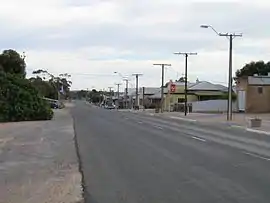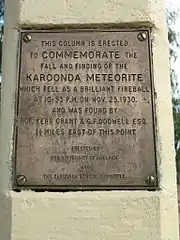| Karoonda South Australia | |||||||||||||||
|---|---|---|---|---|---|---|---|---|---|---|---|---|---|---|---|
 Main Street of Karoonda | |||||||||||||||
 Karoonda | |||||||||||||||
| Coordinates | 35°05′40″S 139°53′45″E / 35.094459°S 139.895888°E[1] | ||||||||||||||
| Population | 337 (UCL 2021)[2] | ||||||||||||||
| Established | 11 December 1913 (town) 11 November 1999 (locality)[3][1][4] | ||||||||||||||
| Postcode(s) | 5307[5] | ||||||||||||||
| Time zone | ACST (UTC+9:30) | ||||||||||||||
| • Summer (DST) | ACDT (UTC+10:30) | ||||||||||||||
| Location | 119 km (74 mi) E of Adelaide | ||||||||||||||
| LGA(s) | District Council of Karoonda East Murray | ||||||||||||||
| Region | Murray and Mallee[1] | ||||||||||||||
| County | Buccleuch[1] | ||||||||||||||
| State electorate(s) | Hammond[6] | ||||||||||||||
| Federal division(s) | Barker[7] | ||||||||||||||
| |||||||||||||||
| |||||||||||||||
| Footnotes | Adjoining localities[1] | ||||||||||||||

Karoonda is a town in the middle of the Murray Mallee region of South Australia (60 km (37 mi) northeast of Murray Bridge). The current boundaries include the former town of Lowaldie, which was the next stop on the railway line away from Adelaide.
History
Karoonda takes its name from the Aboriginal word for "winter camp".
The town was founded on wheat-growing early in the 20th century (proclaimed on 11 December 1913), but the cleared land is also suitable for raising merino sheep. The Karoonda Development Group instigated and built a larger-than-life sculpture of a Merino ram in the park in the main street to emphasise this. There are even seats with rams heads dotted around the town. A number of other agricultural and horticultural industries are now also represented in the district. Each year the Karoonda Farm Fair is held, a two-day event attracting over 10,000 visitors to the town.
In 1922 the District Council of Karoonda was established, bringing local-level government to the township and surrounding district for the first time.[9]
Karoonda briefly shot to international fame in 1930 when the "Karoonda meteorite" fell to earth just to the east of the town on the night of 25 November. Being of a very rare type and being found only a couple of weeks afterwards, it raised international interest in astronomical circles.[10]
Railways
Railways were built in 1911–1914 to open up the mallee. Karoonda was on the Brown's Well railway line (extended to Barmera in 1928) and became a junction with the Waikerie railway line to the north and the Peebinga railway line to the east (south of the main line).[11]
Both branches were closed in 1990, but the main line through Karoonda remained open until 2015 as the Loxton railway line and was converted from broad gauge to standard gauge.
Governance and demographics
Karoonda is located in the local government area of District Council of Karoonda East Murray, the state electoral district of Hammond and the federal Division of Barker.[7][6][1]
At the 2016 census, the locality of Karoonda had a population of 512, of which 351 were living in and around the town of Karoonda.[12][13][1] In Karoonda locality 90.6% of people were born in Australia and 93.3% of people spoke only English at home. The most common responses for religion were Uniting Church 25.0% and No Religion 22.4%.[12]
Facilities and attractions
Karoonda Area School was the first area school in South Australia.
Pioneer Park on East Terrace is being developed as a Malleelands Pioneer Railways and farm museum, with displays of harvest machinery, ploughs, railway rolling stock and facilities already in place. The Nature Trail & Bush Walk is adjacent.
There is an obelisk to commemorate the Karoonda meteorite in the RSL Park on Railway Terrace.[14]
Climate
Karoonda experiences a cold semi-arid climate (Köppen climate classification: BSk), Trewartha: BSal); with warm, dry summers; mild, relatively dry springs and autumns; and mild, relatively dry winters.
| Climate data for Karoonda, South Australia, Australia (1914-present normals and extremes); 72 m AMSL | |||||||||||||
|---|---|---|---|---|---|---|---|---|---|---|---|---|---|
| Month | Jan | Feb | Mar | Apr | May | Jun | Jul | Aug | Sep | Oct | Nov | Dec | Year |
| Record high °C (°F) | 46.3 (115.3) |
46.3 (115.3) |
42.0 (107.6) |
38.0 (100.4) |
29.5 (85.1) |
24.9 (76.8) |
26.8 (80.2) |
32.0 (89.6) |
34.1 (93.4) |
39.2 (102.6) |
44.2 (111.6) |
47.6 (117.7) |
47.6 (117.7) |
| Mean maximum °C (°F) | 40.1 (104.2) |
38.5 (101.3) |
35.1 (95.2) |
30.0 (86.0) |
23.7 (74.7) |
19.0 (66.2) |
18.5 (65.3) |
22.0 (71.6) |
27.0 (80.6) |
31.5 (88.7) |
36.3 (97.3) |
38.4 (101.1) |
40.1 (104.2) |
| Mean daily maximum °C (°F) | 31.8 (89.2) |
30.3 (86.5) |
27.8 (82.0) |
23.8 (74.8) |
19.1 (66.4) |
16.1 (61.0) |
15.7 (60.3) |
17.3 (63.1) |
20.4 (68.7) |
24.0 (75.2) |
27.5 (81.5) |
29.6 (85.3) |
23.6 (74.5) |
| Daily mean °C (°F) | 23.2 (73.8) |
22.2 (72.0) |
20.0 (68.0) |
16.8 (62.2) |
13.1 (55.6) |
10.6 (51.1) |
10.3 (50.5) |
11.2 (52.2) |
13.4 (56.1) |
16.2 (61.2) |
19.3 (66.7) |
21.2 (70.2) |
16.5 (61.6) |
| Mean daily minimum °C (°F) | 14.6 (58.3) |
14.0 (57.2) |
12.1 (53.8) |
9.7 (49.5) |
7.1 (44.8) |
5.1 (41.2) |
4.8 (40.6) |
5.0 (41.0) |
6.4 (43.5) |
8.3 (46.9) |
11.1 (52.0) |
12.7 (54.9) |
9.2 (48.6) |
| Mean minimum °C (°F) | 10.0 (50.0) |
9.5 (49.1) |
7.6 (45.7) |
5.4 (41.7) |
3.0 (37.4) |
1.3 (34.3) |
0.8 (33.4) |
0.8 (33.4) |
2.0 (35.6) |
3.0 (37.4) |
6.4 (43.5) |
8.0 (46.4) |
0.8 (33.4) |
| Record low °C (°F) | 6.4 (43.5) |
6.8 (44.2) |
4.0 (39.2) |
2.0 (35.6) |
−3.0 (26.6) |
−4.0 (24.8) |
−3.1 (26.4) |
−2.3 (27.9) |
−1.9 (28.6) |
0.6 (33.1) |
2.5 (36.5) |
4.3 (39.7) |
−4.0 (24.8) |
| Average precipitation mm (inches) | 17.7 (0.70) |
19.9 (0.78) |
17.1 (0.67) |
24.4 (0.96) |
35.1 (1.38) |
34.5 (1.36) |
34.9 (1.37) |
37.9 (1.49) |
35.2 (1.39) |
31.3 (1.23) |
23.9 (0.94) |
24.4 (0.96) |
336.3 (13.23) |
| Average precipitation days (≥ 1.0 mm) | 2.5 | 2.4 | 2.4 | 4.3 | 6.5 | 7.0 | 8.0 | 8.3 | 6.7 | 5.6 | 4.0 | 3.4 | 61.1 |
| Source: Australian Bureau of Meteorology (1914-present normals and extremes)[15] | |||||||||||||
Lowaldie
The Lowaldie railway station was 6.25 miles (10.06 km) east of Karoonda and also had a small town surveyed, with a school and post office operating for some time. These have all closed, and the former institute building is used as a private residence. The station was originally named Lowalde in 1913, but when the town was proclaimed in 1914, the spelling used was Lowaldie. The name is derived from a Ngarrindjeri word meaning "summer".[16][17]
Photo gallery
 Post Office
Post Office General Store
General Store ABB Silos
ABB Silos Old Railway Station
Old Railway Station Police Memorial, Railway Tce
Police Memorial, Railway Tce Lions Pioneer Park
Lions Pioneer Park Painting at Parking Bay
Painting at Parking Bay Memorial Gates at the Oval
Memorial Gates at the Oval Obelisk
Obelisk Obelisk
Obelisk Area School
Area School Area School
Area School Oval
Oval Institute
Institute Hospital
Hospital Karoonda Pub
Karoonda Pub "All Hallows" Anglican Church
"All Hallows" Anglican Church St Finian's Catholic Church
St Finian's Catholic Church St Johns Lutheran Church
St Johns Lutheran Church Uniting Church
Uniting Church Op-Shop
Op-Shop Ambulance Station
Ambulance Station CFS Station
CFS Station Police Station
Police Station
References
- 1 2 3 4 5 6 7 "Search results for 'Karoonda, LOCB' with the following datasets being selected – 'Suburbs and Localities', 'Government Towns', 'Counties', 'Local Government Areas', 'SA Government Regions', 'Railways' and 'Gazetteer'". Location SA Map Viewer. Government of South Australia. Retrieved 6 May 2018.
- ↑ Australian Bureau of Statistics (28 June 2022). "Karoonda (urban centre and locality)". Australian Census 2021.
- ↑ Bice, John G. (11 December 1913). "TOWN OF KAROONDA" (PDF). The South Australian Government Gazette. Government of South Australia: 1678. Retrieved 6 May 2018.
- ↑ Kentish, P.M. (11 November 1999). "GEOGRAPHICAL NAMES ACT 1991 Notice to Assign Boundaries to Places (in the District Council of Karoonda East Murray)" (PDF). The South Australian Government Gazette. South Australian Government. p. 2321. Retrieved 5 May 2018.
- ↑ "Postcode for Karoonda, South Australia". Postcodes Australia. Retrieved 9 May 2018.
- 1 2 "District of Hammond profile". Electoral Commission SA. Retrieved 6 April 2019.
- 1 2 "Federal electoral division of Barker, boundary gazetted 16 December 2011" (PDF). Australian Electoral Commission. Retrieved 6 April 2019.
- 1 2 3 "Monthly climate statistics: Summary (climate) statistics KAROONDA (nearest weather station)". Commonwealth of Australia, Bureau of Meteorology. Retrieved 16 January 2019.
- ↑ "Constitution of District Council of Karoonda" (PDF). South Australian Government Gazette. 1922 (4): 157. 26 January 1922. Retrieved 16 April 2019.
- ↑ Landau, Sophie (18 October 2022). "Meteorite that put Karoonda on the map 92 years ago heads to South Australian Museum". ABC News. Australian Broadcasting Corporation. Retrieved 21 October 2022.
- ↑ Rail Line to Nowhere Southwell, J.G. Australian Railway Historical Society Bulletin, July, 1971 pp146-151
- 1 2 Australian Bureau of Statistics (27 June 2017). "Karoonda (locality)". 2016 Census QuickStats. Retrieved 7 May 2018.
- ↑ Australian Bureau of Statistics (27 June 2017). "Karoonda (urban centre)". 2016 Census QuickStats. Retrieved 7 May 2018.
- ↑ "Karoonda Meteorite". Monument Australia. Retrieved 20 October 2022.
- ↑ "Karoonda, SA Climate (1914-present normals and extremes)". Australian Bureau of Meteorology. Retrieved 5 June 2022.
- ↑ Bice, John G. (2 April 1914). "TOWNS OF BORRIKA AND LOWALDIE" (PDF). The South Australian Government Gazette. Government of South Australia: 810. Retrieved 6 May 2018.
- ↑ "Placename Details: Lowaldie". Property Location Browser. Government of South Australia. 12 May 2011. Archived from the original on 12 October 2016. Retrieved 12 February 2016.
Narinyeri word meaning summer. Town surveyed in November 1913. Name altered when the town was proclaimed – no indication is given on the glossary card as to the name originally proposed but old cards show Lowalde. Town diminished in February 1938. Now incorporated into the bounded locality of Karoonda.